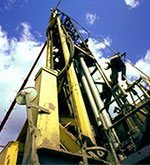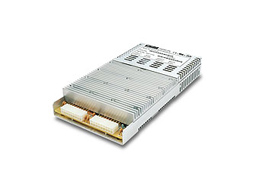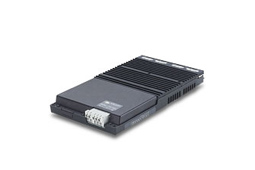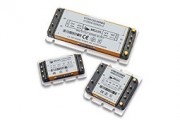Successful Applications
FlatPAC EN Powers a Ruggedized Industrial Automation Application

Automation is the use of control systems (such as numerical control, programmable logic control, and other industrial control systems), in concert with other applications of information technology (such as computer-aided technologies [CAD, CAM, CAx]), to control industrial machinery and processes, reducing the need for human intervention. In the scope of industrialization, automation is a step beyond mechanization. Whereas mechanization provided human operators with machinery to assist them with the physical requirements of work, automation greatly reduces the need for human sensory and mental requirements as well. Processes and systems can also be automated.
Our customer is a provider of — among other products and services — vertically integrated electronics manufacturing solutions. This application uses a ruggedized embedded computer for an industrial automation system, which is ultimately used as part of a protection system for a nuclear power plant.
FlatPAC-EN is a rugged, EN-compliant, autoranging AC-DC switcher that meets MIL-STD-810E requirements for vibration. One additional important requirement for the power solution was to satisfy the harmonic current provisions of EN61000-3-2. For the last few years, compliance to EN61000-3-2 has been required in order to do business within the European Economic Community. FlatPAC does, in fact , comply with harmonic current limits per EN61000-3-2, and further, also — valuable for this application — meets Electrical Fast Transient/Burst per EN61000-4-4 and Surge Immunity per EN61000-4-4. For conducted EMI, the FlatPAC also conforms with FCC Class A and B and EN55022, Class A and B.
MegaMods, ComPACs, and Application Notes Combine to Charge the Batteries of Mining Vehicles and Equipment

Mining has been going on for more than 40,000 years. Miners employed ingenious methods such as fire to break down hard rock that contained the desired metal. Or they used water delivered to the site by aqueducts to wash the crushed ore and separate the metal. They also used both; fire at first to heat the rock, then water to quench the fire, causing thermal shock that cracked the rock. But mostly they used human labor. For centuries, mining has been done by hard, dangerous physical labor. Today, mining is characterized by heavy machinery: huge trucks, bulldozers, drills, elevators, crushers, and more. Mining is not only much more effective than it has ever been, it’s even safer and more environmentally friendly.
A world-class producer of copper, gold and molybdenum possesses a large fleet of gargantuan-sized vehicles, many of which require battery backup systems. Batteries, of course, occasionally require that they be charged. Battery chargers using ComPACs and MegaMods were developed in-house for use with their vehicle fleet of approximately 50 trucks, bulldozers, and shovels. An important element in this application was the availability of Vicor application notes, especially „Constant Current Control for DC-DC Converters.“ The field-proven ComPAC DC-DC switchers were 24 Vin and 24 Vout with output power of 200 W. The MegaMod, Jr. DC-DC converters in rugged, chassis-mount packages were also 24 Vin, 24 Vout, but with output power of 25 W.
Vicor Wide Input Range Mini Covers All Forklift Input Voltage Variations

The forklift came into being in the 1920s, but became commonplace during World War II, partly because of the labor shortages, but also because of the heightened need for efficient production. Today, of course, forklifts are prevalent in just about every manufacturing plant, warehouse, distribution center, or anyplace where items are stored and moved in bulk.
Our customer is a European company that specializes in the production of electronic components for the automotive industry. This particular application is a power supply for electrical, rather than gas or diesel, forklifts that are used mostly indoors. Previously, they used a number of different modules depending on the input voltage from the traction battery. The Vicor 72 V input Mini, with an input range of 43 V to 110 V, covers the complete input voltage range that they need. As a consequence, only one module is needed for all variations of the systems, resulting in lower cost for logistics and stock. These models meet the operating voltage requirements for EN50155, the key standard for railway applications, as well as EN50155 requirements for shock, vibration, and temperature.
The Vicor modules are encapsulated rather than open frame, which provides better thermal management, shock and vibration resistance, ruggedness, and reliability. The Vicor price and efficiency were a little better than their previous solution, and because of the space and thermal attributes of the Vicor solution the total cost was lower.
High-Density Vicor DC-DC Converters Power Diverse Laser Applications

The first laser was demonstrated in 1960, and they were still largely the domain of researchers for the next ten or 15 years. Today, lasers are ubiquitous; they are indispensable tools in science, industry, medicine, and consumer electronics, adding up to a multi-billion dollar industry. Real-world applications for lasers now include rangefinding, tracking, ablation, bathymetry, semiconductor processing, remote sensing, article imaging, spectroscopy, welding, ocean science, designation, laser cleaning and surface preparation, illumination, dermatology and hair removal.
The design engineer at one laser manufacturer has been relying on Vicor solutions because of their high density for over 20 years, originally for another company for airborne military applications. Now one of his applications is a full mil airborne system that uses eight custom micros with a unique output voltage for each and contains two other mil-grade products: ten Vicor products in one laser. In fact, he said, „all of our lasers have Vicor modules in them.“ He was emphatic: „commercial laser systems that go out into the real world need to be ruggedized. But it’s just as important that the associated electronics be ruggedized as well.“ As a result, he places high value on Vicor power components because they are fully sealed—they are encapsulated ― and he is „most impressed by their high power density, which works well in our types of applications.“



